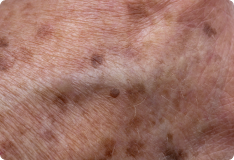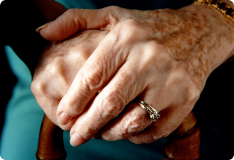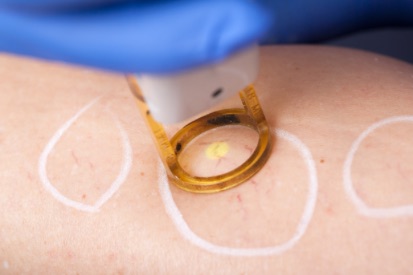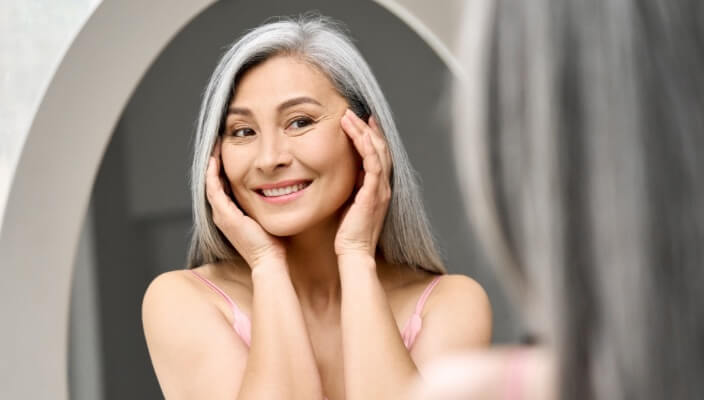Age Spots
Understanding and Treating Age Spots
Age spots, also known as liver spots or solar lentigines, are flat, darkened patches that commonly appear on the skin as a result of prolonged sun exposure. These spots are most frequently found on areas of the body that receive the most sun, such as the face, hands, neck, exposed scalp, and arms. Age spots are caused by an overproduction of melanin, the pigment responsible for skin color, which becomes concentrated in certain areas due to the cumulative effects of ultraviolet (UV) radiation over time.
Although age spots are generally harmless, they can be cosmetically concerning for many individuals. Additionally, because they can sometimes resemble more serious conditions, such as melanoma, it’s essential to have them evaluated by a dermatologist.
Our expert dermatology providers at Cumberland Skin can accurately differentiate between benign age spots and potentially harmful lesions, ensuring you receive the proper diagnosis and treatment recommendations. We offer personalized care to address your concerns and help you achieve healthier, clearer skin.
Schedule an appointment with one of our Cumberland Skin specialists to discuss the most effective treatment plan for your age spots and explore options to prevent future occurrences.
Examples of Age Spots



Symptoms of Age Spots
- Flat, Oval Shapes: Age spots are flat, oval-shaped areas of skin with no raised texture.
- Brown, Gray, or Black Color: Often appear in shades of brown, gray, or black.
- Small to Medium Size: Age spots can range in size from small to medium.
- Common Areas: They frequently occur on sun-exposed areas such as the face, hands, shoulders, and arms.
Causes of Age Spots
- Age spots are more likely to appear on people whose lifestyle exposes them to the sun.
- Over time, the skin loses its ability to repair itself after sun exposure and the spots appear.
Preventing Age Spots
FAQs: Age Spots
Age spots are generally harmless and not indicative of a serious medical condition. However, it's essential to differentiate age spots from other skin conditions, such as melanoma, which is a type of skin cancer. If you notice any changes in the appearance of your spots, including size, color, or irregular borders, or if they become itchy or bleed, it's crucial to consult with your dermatologist.
Age spots do not typically fade naturally, but their appearance may be influenced by sun protection measures. Regular use of sunscreen and sun-protective measures can prevent the spots from darkening.
Age spots and freckles are distinct skin conditions. Freckles, also known as ephelides, are generally smaller, lighter in color, and often appear in individuals with fair skin. They are caused by an increase in melanin production and are usually genetic. Age spots, on the other hand, are larger, darker, and are associated with both aging and sun exposure. While freckles may darken with sun exposure, age spots are more likely to develop in areas that receive chronic sun exposure over many years.
While sun exposure is a primary factor in the development of age spots, they can also occur in areas not directly exposed to the sun. Other factors, such as genetics, can contribute to the formation of age spots. Additionally, artificial sources of UV radiation, such as tanning beds, can also increase the risk of age spot formation. It's important to practice sun protection and be aware of overall sun exposure.
Age spots are primarily caused by prolonged exposure to the sun's harmful ultraviolet (UV) rays. Over time, this exposure can lead to an accumulation of melanin, the pigment responsible for skin color. This excess melanin forms dark spots or patches on the skin, commonly appearing on areas frequently exposed to the sun, such as the face, hands, shoulders, and arms.
From Our QualDerm Family of Brands: What Are Age Spots?
Treatments for Age Spots
If one opts to treat age or sun spots, there are cosmetic options, including:
- Laser Therapy: Lasers can target pigment in age spots, breaking it down and allowing the body to naturally eliminate the discolored cells.
- Chemical Peels: A chemical solution is applied to the skin, causing it to peel and new, evenly pigmented skin to replace the old skin.
- Microdermabrasion: This procedure involves gently exfoliating the outer layer of skin, which can help reduce the appearance of age spots.
Related Blog Posts

- General Dermatology
- Cosmetic Treatments
Learn effective strategies for eliminating spider veins in this informative blog. Discover various treatment options and lifestyle changes that can help you achieve smoother, vein-free skin, empowering you to confidently address this common cosmetic concern.
Read More
- Botox
- Injectables or Fillers
- Cosmetic Treatments
Discover expert tips on how to use dermal fillers effectively. Learn about the different types of fillers available and how they can enhance your appearance, empowering you to make informed decisions about your cosmetic treatments.
Read More
- Skin Care
- Cosmetic Treatments
Unlock the secrets to achieving radiant, glowing skin. Explore expert tips and skincare routines tailored to nourish and revitalize your complexion, empowering you to embrace a luminous and youthful appearance.
Read MoreFeatured Products
Check your local office for current stock!
Check your local office for current stock!


